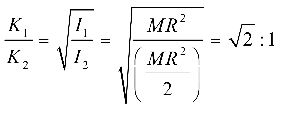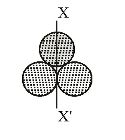System of Particles and Rotational Motion
- A small mass attached to a string rotates on frictionless table top as shown. If the tension in the string is increased by pulling the string causing the radius of the circular motion to decrease by a factor of 2, the kinetic energy of the mass will

-
View Hint View Answer Discuss in Forum
K.E. = L²/2I
The angular momentum L remains conserved about the centre.
That is, L = constant.
I = mr²
∴ K.E. = L²/2mr²
In 2nd case,
K.E. = L²/2(mr'²)
But r′ = r/2∴ K.E' = L² = 4L² ⇒ K.E.′ = 4 K.E. MLω² 2 2m.(r²/4) 2mr²
∴ K.E. is increased by a factor of 4.Correct Option: C
K.E. = L²/2I
The angular momentum L remains conserved about the centre.
That is, L = constant.
I = mr²
∴ K.E. = L²/2mr²
In 2nd case,
K.E. = L²/2(mr'²)
But r′ = r/2∴ K.E' = L² = 4L² ⇒ K.E.′ = 4 K.E. MLω² 2 2m.(r²/4) 2mr²
∴ K.E. is increased by a factor of 4.
- The moment of inertia of a thin uniform rod of mass M and length L about an axis passing through its midpoint and perpendicular to its length is I0. Its moment of inertia about an axis passing through one of its ends and perpendicular to its length is
-
View Hint View Answer Discuss in Forum
By theorem of parallel axes,
I = Icm + Md²
I = I0 + M (L/2)² = I0 + ML²/4Correct Option: B
By theorem of parallel axes,
I = Icm + Md²
I = I0 + M (L/2)² = I0 + ML²/4
- The moment of inertia of a uniform circular disc is maximum about an axis perpendicular to the disc and passing through :

-
View Hint View Answer Discuss in Forum
According to parallel axis theorem of the moment of Inertia
I = Icm + md²
d is maximum for point B so Imax about B.Correct Option: A
According to parallel axis theorem of the moment of Inertia
I = Icm + md²
d is maximum for point B so Imax about B.
- The ratio of radii of gyration of a circular ring and a circular disc, of the same mass and radius, about an axis passing through their centres and perpendicular to their planes are
-
View Hint View Answer Discuss in Forum
I = MK²
∴ K = √I/M
Iring = MR² and Idisc = (1/2)MR²
Correct Option: A
I = MK²
∴ K = √I/M
Iring = MR² and Idisc = (1/2)MR²
- Three identical spherical shells, each of mass m and radius r are placed as shown in figure. Consider an axis XX' which is touching to two shells and passing through diameter of third shell. Moment of inertia of the system consisting of these three spherical shells about XX' axis is

-
View Hint View Answer Discuss in Forum
Moment of inertia of shell 1 along diameter
Idiameter = (2/3) MR²
Moment of inertia of shell 2 = m. i of shell 3= Itangential = 2 MR² + MR² = 5 MR² 3 3
So, I of the system along x x1
= Idiameter + (Itangential) × 2
or,= Itotal = 2 MR² + 
5 MR² 
× 2 3 3 = 12 MR² = 4MR² 3
Correct Option: C
Moment of inertia of shell 1 along diameter
Idiameter = (2/3) MR²
Moment of inertia of shell 2 = m. i of shell 3= Itangential = 2 MR² + MR² = 5 MR² 3 3
So, I of the system along x x1
= Idiameter + (Itangential) × 2
or,= Itotal = 2 MR² + 
5 MR² 
× 2 3 3 = 12 MR² = 4MR² 3

